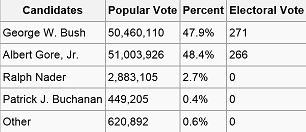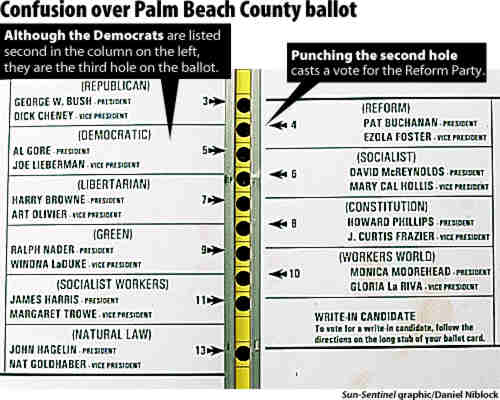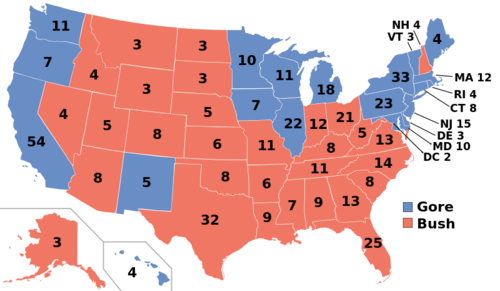Contents
The 2000 election and what it should teach us
A team project for MA279, Fall 2013
Team members: S. Butts, H. Guo, D. Koishybayev, S. Lemmon
Introduction
Counting Methods
In chapter 1 we have learned several counting methods. Although all these methods look fair, they may produce completely different results in some situation. Therefore, the study of these methods can help us better understand the result of presidential election of 2000.
The plurality method
The plurality method is the most commonly used method to find a winner. In plurality method, only the first-place vote is considered, and the candidate with most first-place votes wins. The plurality method is actually the method used in the presidential election in the United States. The major advantage for plurality method is that it satisfies the majority criterion, which claims that the majority candidate (the candidate winning majority of first-place votes) should be the winner of the election.
However, the plurality method does have drawback. Since the plurality method never takes the voter’s preference on all other candidates into account, it violates Condorcet criterion, which means that even if the candidate is preferred over each of the other candidates in the head-to-head comparison, this candidate may still not win in the election.
The Borda count method
The Borda count method, unlike the plurality method, utilizes more information from the ballot by assigning points to each place on a ballot. In an election with n candidates, we give 1 point for the last place, 2 points for second last place, and so on, so each first-place vote earns the candidate N points. Eventually, the candidate with the highest points becomes the winner. This method looks like a perfectly fair method, for it takes into account all the information on the ballot, and the winner is the candidate with the highest average ranking. However, the method violates both the majority criterion and Condorcet criterion.
The plurality-with-elimination method
The plurality-with-elimination method, also known as instant runoff method, is an efficient way to conduct a runoff election. To apply this method, we need to use preference ballots instead of just the first-place vote. After the first-place votes for each candidate is determined, the candidate with the fewest votes will be eliminated from the election, as well as all from the preference schedules. This process will continue until there is only one candidate remaining, who becomes the winner of this election. ,
Although the plurality-with-elimination method satisfies the majority criterion, it violates the Condorcet criterion, as well as monotonicity criterion, which states that the winner of the election should remain the same as the long as the changes of the ballots still favors the winner. However, despite its flaws, the plurality-with-elimination method is a popular method and is used in many elections.
The method of pairwise comparisons
One method that does not violate Condorcet criterion is the method of pairwise comparisons. In a pairwise comparison, which is a head-to-head match between two candidates, each votes goes to one candidate if this candidate ranked higher than another one on this vote. The candidate with more votes is the winner of this pairwise comparison. The winner gets one point and the loser gets none, and both gets 1/2 points if there is a tie. Once all the pairwise comparisons are done, the candidates with the most points wins. Besides Condorcet criterion, this method also preserves majority criterion, as well as monotonicity criterion. However, it violates the independence-of-irrelevant-alternatives criterion, which asserts that the winner should not change while a non-winning candidate withdraws.
Extended Ranking methods and recursive ranking methods
Each of the above methods has a corresponding extended ranking method and a recursive ranking method. The extended ranking method will just run the corresponding method once and rank each candidate based on points earned. The recursive ranking method, in the contrast, first run the corresponding method to determine winner as the first place, and eliminate the winner from the election, and run this method again to get another winner to be the second place, and so on, until all the candidates are ranked.
Overview of the Presidential Election in 2000
Presidential election of 2000 has one of the close election results in the U.S. history. In this contest, Republican candidate George W. Bush won 47.9% popular vote, while the Democratic candidate Al Gore got 48.4%. Although failing to win the plurality of the popular vote, George W. Bush still won the election with more electoral votes. This was the 16th time in history that a candidate won the Electoral College vote without receiving the majority of the nation's popular vote. Election results hinged on Florida, where a major recount dispute took place. However, the United States Supreme Court called off the recount eventually, and the result was in favor of George W. Bush and brought him the final victory. However, later studies have conflicting opinions on who would have won had the recount in Florida had been allowed to proceed.
George W. Bush managed to carry the Southern states by comfortable margins, and also swept most of the Midwestern states, as well as Ohio, Alaska, and Indiana. Al Gore, on the other hand, secured wins in most of the Upper Midwest, the Pacific Coast, the Northeastern United States, and Hawaii, as well. The results in a handful of small-to-medium sized states were extremely close. In fact, there were more than 5 states (6 states in total, including Florida, New Mexico, Wisconsin, Iowa, Oregon, and New Hampshire) where the margin of victory was less than 2 percent. However, it was the state of Florida that would determine the winner of the election. As the final national results were tallied, Bush had won a total of 246 electoral votes, while Gore had won 255 votes. Since there were 538 electoral votes of the Electoral College, 270 votes were needed to win. Although New Mexico and Oregon were still too close to call, their electoral votes (5 electoral votes for New Mexico and 7 electoral votes for Oregon) were not enough to bring either candidate the final victory. Therefore, 25 electoral votes from Florida became the key to the election win. Because of the process of counting and then recounting Florida's presidential ballots, the outcome of the election was not known for more than a month after the balloting ended.
The Election Results eventually showed:
Data: States where the margin of victory was less than 2%:
Florida, 25 Electoral Vote, 0.0092%,
New Mexico, 5 Electoral Vote, 0.06%,
Wisconsin, 11 Electoral Vote, 0.22%,
Iowa, 7 Electoral Vote, 0.31%
Oregon, 7 Electoral Vote, 0.44%
New Hampshire, 4 Electoral Vote, 1.27%
Source: U.S. Government document [4]
The Florida Recount
In every election, Florida is considered quite an important state due to the fact that it is one of the largest, in terms of Electoral College votes, swing states in the US. In US presidential elections, a swing state is a state that is so close in terms of Democratic and Republican votes that it changes from each election. But in 2000, Florida was the most important state when the final tallies were coming in, and due to voting complications caused the outcome of the election to be delayed for over a month.
On election night, all but three states have counted their votes and winners of the state were decided. At the point in the tally, Bush had 246 electoral votes and Gore had 255 with remaining states being New Mexico who gave 5 Electoral Votes, Oregon who gave 7 Electoral Votes, and Florida who gave 25 Electoral Votes. New Mexico and Oregon became dummies since even if both of them went to the same person; the other person would win if they received Florida.
The whole controversy began when media outlets started to call the race for Gore based on exit polls; only to retract that when the polls in the panhandle close and started to report that Bush was winning. After some of the more democratic counties of Florida began to close and their votes were counted, the media flipped again and started to report that it was too close to call. When all the poles closed, Bush had won it by a slim 1784 votes, which according to Florida law is a small enough that a recount must be done. After the recount, Bush was only winning by 537 votes.
This prompted Gore to call for a manually recount of the ballots, which was aloud by Florida law. The Florida supreme court passed the recount, but the US Supreme Court stepped in and stopped the recount by giving the case an unsigned per curiam opinion. With this opinion by the US Supreme Court, the last recount was used and bush ended up becoming the president by the small margin of 537 votes.
Another thing that added to the controversy were the irregularities in the ballots across Florida, with the butterfly ballot of Palm Beach being the most criticized. What made this ballot raise so many concerns is that the third party candidate, Pat Buchanan, received an abnormally large amount of votes. Buchanan received .8% of the total vote, which was 3,407 votes, compared to the .29% for the state wide total. This large discrepancy in the votes could be due to the fact that people thought they were voting for Bush or Gore, but were in fact voting for Buchanan. Buchanan even said himself on The Today Show, “When I took one look at that ballot on Election Night ... it's very easy for me to see how someone could have voted for me in the belief they voted for Al Gore.”. Below is an image of the ballot and the confusion people may have had.
Electoral Vote versus Popular Vote
In the United States, although citizens vote directly for their chosen candidate in the presidential election, the institution called the Electoral College officially elects the President and Vice President. However, the members of Electoral College, also known as “electors”, are actually chosen by the popular vote. With such setting, it is possible that the candidate wins the popular vote but loss the presidential election because of the electoral vote.
There are 538 total electors in the Electoral College, which are distributed to each state and the District of Columbia based on Census. The distribution of electoral vote to which each state and D.C. was entitled for 2000 election can be found in the following map:
In all states except Nebraska and Maine, electors are awarded on a winner-take-all basis. That means when George W. Bush won Florida with only several hundred popular vote surplus (0.0092% surplus), he won all 25 electoral votes for Florida, which is a big number of electoral votes.
What if Scenario
Sponsored by major U.S. news organizations, National Opinion Research Center at the University of Chicago conducted a comprehensive review of all ballots uncounted in the Florida 2000 presidential election. The result of the recount study can be found from the following table.
| Candidate outcomes based on potential non-absentee recounts in Florida presidential election 2000 |
||
| Review method | Winner | |
|---|---|---|
| Review of all ballots statewide (never undertaken) | ||
| • | Including dimples, optical marks, or overvotes | Gore by 171 |
| • | Fully punched chad and limited marks on optical ballots | Gore by 115 |
| • | Any dimples or optical mark | Gore by 107 |
| • | One corner of chad detached or optical mark | Gore by 60 |
| Review of limited sets of ballots (initiated but not completed) | ||
| • | Gore request for recounts of all ballots in Broward, Miami-Dade, Palm Beach, and Volusia counties | Bush by 225 |
| • | Florida Supreme Court of all undervotes statewide | Bush by 430 |
| • | Florida Supreme Court as being implemented by the counties, some of whom refused and some counted overvotes as well as undervotes | Bush by 493 |
| Unofficial recount totals | ||
| • | Incomplete result when the Supreme Court stayed the recount (December 9, 2000) | Bush by 154 |
| Certified Result (official final count) | ||
| • | Recounts included from Volusia and Broward only | Bush by 537 |
Source: Washingtonpost [6]
Conclusion
In the story above, we can see the result of election can change dramatically depends on how we decide to count the votes. From the study of National Opinion Research Center at the University of Chicago we can say that either of George W. Bush or Al Gore could win, as long as the “right” vote counting method had been chosen. An amazing fact is that, although leading to significantly different election results, all the vote counting methods that had been proposed during the research look good. So which vote counting method should be considered as the “right” one for the election? It seems this problem can be nicely solved if we can find an absolutely fair vote counting method. However, to our surprise, after a careful review of the most commonly used vote counting method, it seems that none of them are “fair”; each of these methods violates (in some cases) at least one fairness criterion. Actually, according to Arrow’s impossibility theorem, it is mathematically impossible for a democratic voting method to satisfy all of the fairness criteria. Therefore, surprisingly, it seems making decision s in a consistently fair way is not even possible.
Reference:
[1] 2000 Election Electoral College
[2] "Electoral Vote vs Popular Vote". Diffen contributors. Diffen LLC, 2013. Web. Sat Nov 30 2013
[3] 2000 Presidential General Election Results
[4] U.S. Government document: 2000 OFFICIAL PRESIDENTIAL GENERAL ELECTION RESULTS
[5] The Electoral College
[6] Florida Recounts Would Have Favored Bush
[7] The Florida Ballots Project documentation, data, and data layout files




